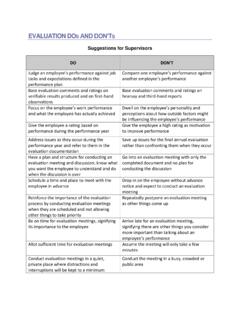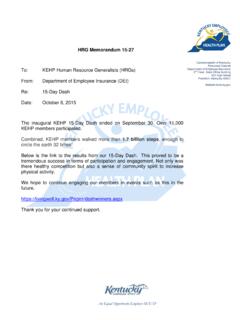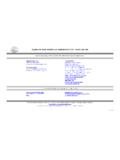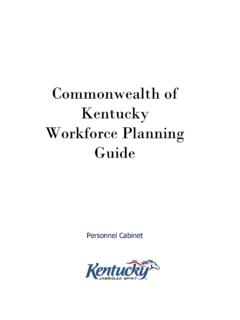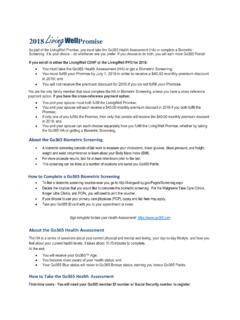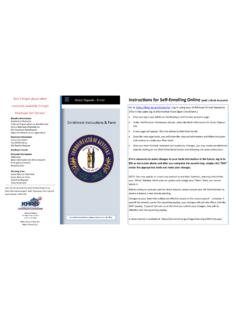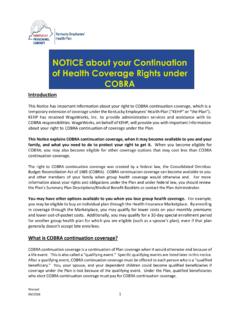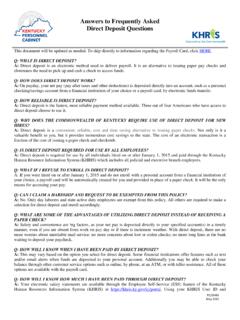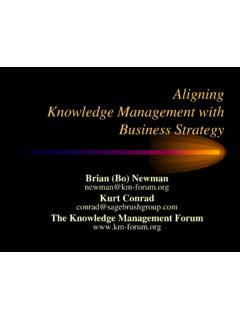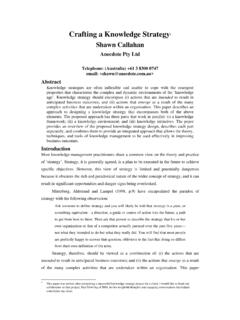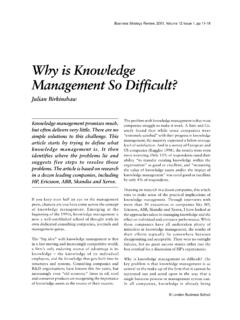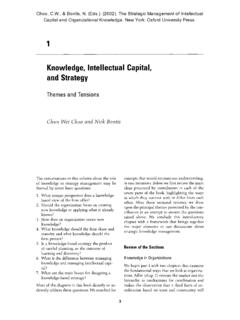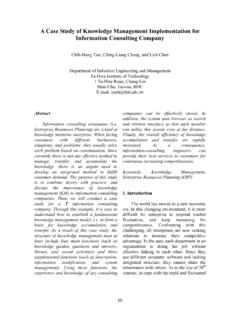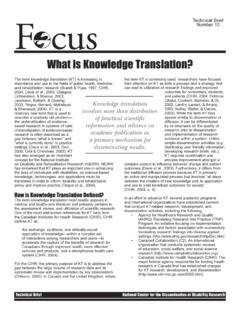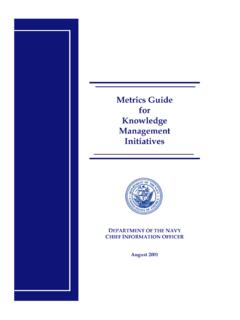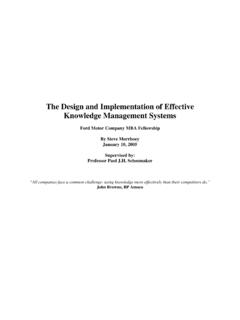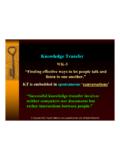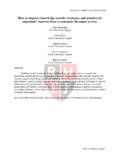Transcription of Commonwealth of Kentucky Knowledge Management & …
1 Commonwealth of Kentucky Knowledge Management & transfer Personnel Cabinet Office of Diversity, Equality & Training 2 Table of Contents Overview of Knowledge Management / transfer 5 Developing a Knowledge / transfer Plan 7 Overview of Knowledge Management / transfer Strategies 13 Knowledge Management / transfer Strategies 17 Co-op/Internships 18 Best Practices 20 Communities of Practice 22 Expert Interviews 25 Job Aids 27 Knowledge Fairs 29 Learning Games 30 After Action Reviews 32 Mentoring 35 On-the-Job Training 38
2 Storytelling 40 Training 43 Office of Diversity, Equality & Training 3 OVERVIEW OF Knowledge Management / transfer Knowledge Management (KM) refers to practices used by organizations to find, create, and distribute Knowledge for reuse, awareness, and learning across the organization. Knowledge Management programs are typically tied to organizational objectives and are intended to lead to the achievement of specific outcomes such as shared intelligence, improved performance, or higher levels of innovation. Knowledge transfer (an aspect of Knowledge Management ) has always existed in one form or another through on-the-job discussions with peers, apprenticeship, and maintenance of agency libraries, professional training and mentoring programs.
3 Since the late twentieth century, technology has played a vital role in Knowledge transfer through the creation of Knowledge bases, expert systems, and other Knowledge repositories. To understand Knowledge Management and Knowledge transfer , it is helpful to examine the differences between data, information, and Knowledge . Data is discrete, objective facts. Data is the raw material for creating information. By itself, data carries no judgment, interpretation or meaning. Information is data that is organized, patterned and/or categorized.
4 It has been sorted, analyzed and displayed, and is communicated through various means. Information changes the way a person perceives something, thus, affecting judgment or behavior. Knowledge is what is known. It is richer and more meaningful than information. Knowledge is gained through experience, reasoning, intuition, and learning. Because Knowledge is intuitive, it is difficult to structure, can be hard to capture on machines, and is a challenge to transfer . We often speak of a "knowledgeable person," and by that we mean someone who is well informed, and thoroughly versed in a given area.
5 We expand our Knowledge when others share theirs with us. We create new Knowledge when we pool our Knowledge together. Office of Diversity, Equality & Training 4 The Working Council of the Federal Chief Information Officers Council in its publication "Managing Knowledge at Work: An Overview of Knowledge Management " illustrates these differences in the simplest terms: Data = Unorganized Facts Information = Data + Context Knowledge = Information + Judgment Tacit versus Explicit Knowledge A key distinction made by the majority of Knowledge Management practitioners is the distinction between tacit and explicit Knowledge .
6 Tacit Knowledge is often subconscious, internalized, and the individual may or may not be aware of what he or she knows and how he or she accomplishes particular results. At the opposite end of the spectrum is conscious or explicit Knowledge - Knowledge that the individual holds explicitly and consciously in mental focus, and may communicate to others. In the popular form of the distinction, tacit Knowledge is what is in our heads, and explicit Knowledge is what we have arranged into an organized system. Tacit Knowledge is often difficult to access.
7 People are not aware of the Knowledge they possess or how valuable it may be to others. Tacit Knowledge is considered more valuable because it provides context for people, places, ideas, and experiences. Effective transfer of tacit Knowledge generally requires extensive personal contact and trust. Explicit Knowledge is relatively easy to capture and store in databases and documents. It is shared with a high degree of accuracy. It may be either structured or unstructured: o Structured - Individual elements are organized or diagramed in a particular way for future retrieval.
8 It includes documents, databases, and spreadsheets. o Unstructured - The information is not referenced for retrieval. Examples include e-mail messages, images, training courses, and audio and video selections. The goal of KM is not to capture all Knowledge , but rather manage the Knowledge that is most important to the organization. It involves applying the collective Knowledge and abilities of the entire workforce to achieve specific organizational objectives. Office of Diversity, Equality & Training 5 DEVELOPING A Knowledge Management / transfer PLAN Ideally, capturing and sharing critical Knowledge and expertise should be occurring continuously among employees.
9 In many cases, however, it is not and this need becomes pressing when a valued employee is preparing to retire or change positions. Attached you will find a simple tool that can be used to capture some of that Knowledge and experience before employees leave the organization. This is a tool designed for the employee to complete as they look back over their career and evaluate the impact of their departure. In addition, there are tools available for more in-depth Management of Knowledge and experience in your organization. Please contact an Office of Diversity, Equality & Training (ODET) consultant for more information.
10 Before using the attached tool, there are a few things to think about: Is the organization going to fill the vacant position or reassign the duties? Are all the duties of the position still important to the mission of the organization? Is there a need to update the position description? Will the position change, remain as is, or be eliminated once the employee leaves? By having the employee complete the attached tool, data can be collected as to the tasks and activities that are currently being accomplished.

